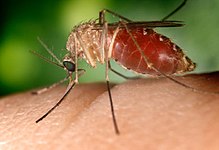Sindbis virus
| Sindbis virus | ||||||||||||||||||||
|---|---|---|---|---|---|---|---|---|---|---|---|---|---|---|---|---|---|---|---|---|

Scale cross section of the Sindbis virus |
||||||||||||||||||||
| Systematics | ||||||||||||||||||||
|
||||||||||||||||||||
| Taxonomic characteristics | ||||||||||||||||||||
|
||||||||||||||||||||
| Scientific name | ||||||||||||||||||||
| Sindbis virus | ||||||||||||||||||||
| Short name | ||||||||||||||||||||
| SINV | ||||||||||||||||||||
| Left | ||||||||||||||||||||
|
The Sindbis virus ( SINV ) is a virus species from the genus Alphavirus . It is the causative agent of a mostly harmless febrile illness with inflammation of the joints, which is sometimes associated with skin rashes and rarely with encephalitis . The virus is transmitted by mosquitoes and is considered an imported travel infection in Central Europe . Because of its transmission route, it is assigned to the epidemiological group of arboviruses . Some subtypes of Sindbis virus have been identified as causing Karelian fever and Ockelbo fever .
discovery
The Sindbis virus was discovered in 1952 after several mosquito species ( Culex pipiens and C. univittatus ) were removed from a pond near the village of Sindbis or Sindibis ( Arabic سندبيس) about 30 km north of Cairo ( Egypt ) for possible pathogens of an outbreak of febrile illness.
Systematics
The Sindbis virus forms a special group of viruses within the genus Alphavirus (WEEV group, English W estern e quine e ncephalitis v irus complex ) to which the Fort Morgan virus ( Buggy Creek virus ), Highlands-J virus , Western Equine encephalomyelitis virus (WEEV) and Whataroa virus belong. The Sindbis virus species is divided into six subtypes with (historically determined) names of their own:
- Species: Sindbis Virus
- Subtype: Babanki virus (English Babanki virus; the abbreviation BABV also stands for Babahoya virus, subtype of the species Patois orthobunyavirus , genus Orthobunyavirus )
- Subtype: Kyzylagach virus (English Kyzylagach virus, KYZV, Azerbaijan )
- Subtype: Sindbis-like virus
- Subtype: Sindbis-like virus YN87448
- Subtype: Karelian fever virus ( Karelia )
- Subtype: Ockelbo virus (English Ockelbo virus, OCKV, Sweden )
Epidemiology

All alphaviruses are transmitted by blood-sucking vectors . In the case of the Sindbis virus, it is spread by mosquitoes of the genus Culex . Birds are the natural reservoir for the virus. Due to the vector, the distribution of the Sindbis virus is limited to Africa , the eastern Mediterranean, Sicily , South and Southeast Asia , South America and Australia . Infections with the Sindbis and Sindbis-like viruses occurring in Central Europe have so far been imported infections after a stay in endangered regions. The Ockelbo virus was found in Sweden and the Karelian fever virus in the Czech Republic and Karelia . Overall, these virus subtypes are less pathogenic. Because of the bird migration , the presence of the virus in Central Europe was long assumed, but viral RNA of a subtype of the Sindbis virus could only be detected in southern Germany in 2010 in the mosquito species Anopheles maculipennis , Culex torrentium and Culex pipiens . The detected subtype is related to the Swedish subtype (Ockelbo virus). The most common native of mosquito Aedes vexans , however, is not able to propagate the virus and destroyed recorded virus particles of the Sindbis virus by digestion ( proteolytic cleavage ) of the virus envelope .
illness
After an incubation period of 3–4 days, infection with the Sindbis virus only rarely causes a febrile illness (Sindbis fever), sometimes with skin rashes ( exanthema ) and joint problems. The clinical picture is very similar to a dengue infection, which is why the Sindbis virus is also referred to as a so-called dengue-like syndrome. The Sindbis virus infection owes the particularly noticeable symptom of joint inflammation to the name "epidemic polyarthritis ". Sindbis viruses with neurotropic properties and associated encephalitis have been described in a few individual cases .
The infection heals largely without any consequences, even without specific therapy. A vaccination is currently not available.
literature
- DK Lvov, TM Skvortsova et al .: Isolation of Karelian fever agent from Aedes communis mosquitoes . In: Lancet , 1984, 18; 2 (8399), pp. 399-400, PMID 6147473
- DK Lvov, VL Gromashevskii et al .: Kyzylagach virus (family Togaviridae, genus alphaviruses), a new arbovirus isolated from Culex modestus mosquitoes trapped in the Azerbaijani SSR . In: Voprosy virusologii , 1979 Sep-Oct; (5), pp. 519-523, PMID 159565 , ISSN 0507-4088 (Russian first description)
Web links
- Sindbis virus taxonomy of the NCBI
- Sindbis virus genomic reference sequence
- Structure and replication of the Sindbis virus (English; with animations, via WebArchive)
Individual evidence
- ↑ ICTV Master Species List 2018b v1 . MSL # 34, Feb. 2019
- ↑ a b c d ICTV: ICTV Master Species List 2019.v1 , New MSL including all taxa updates since the 2018b release, March 2020 (MSL # 35)
- ^ ICTV Report 1993 (PDF) ICTV. On p. 307 the species is referenced as 'Patios virus group'.
- ↑ Y Shirako et al .: Structure of the Ockelbo virus genome and its relationship to other Sindbis viruses . In: Virology , 182 (2), 1991, pp. 753-764, PMID 1673813
- ↑ H. Jöst et al .: Isolation and phylogenetic analysis of Sindbis viruses from mosquitoes in Germany. In: J. Clin. Microbiol. , 2010, PMID 20335414
- ↑ M Modlmaier et al .: Transmission studies of European Sindbis virus in the floodwater mosquitos Aedes vexans . In: Int. J. Med. Microbiol. , 2002, 291, Suppl 33, pp. 164-170, PMID 12141742